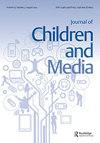沙特儿童的家庭文化和媒体环境
IF 2.1
3区 心理学
Q2 COMMUNICATION
引用次数: 7
摘要
在过去的几年里,儿童对屏幕媒体的使用迅速增加。尽管科技在沙特阿拉伯广泛使用,但关于儿童使用屏幕媒体的研究却很少。本研究提供了沙特阿拉伯220名1至3岁儿童的屏幕媒体使用和识字实践的全面情况。调查结果显示,这些儿童中的绝大多数在两岁之前就开始使用屏幕了。沙特儿童每天看屏幕的总时间约为3小时,超过了世界卫生组织的建议时间。Iftah Ya Simsim(阿拉伯版的芝麻街)是孩子们最喜欢的电视节目,YouTube是他们最喜欢的移动媒体应用,儿童歌曲是他们在移动媒体上最常观看的内容类型。幼儿花在屏幕上的时间比他们花在阅读上的时间要多。超过40%的孩子从来没有人给他们读过书,四分之一的孩子家里没有儿童读物。本研究的结果提供了更好的理解儿童的屏幕使用和阅读习惯;这是指导为所有利益攸关方制定关于幼儿使用屏幕的研究驱动型建议的重要第一步。a.以前的知识状况:早期对发展至关重要。大多数关于数字媒体和儿童早期识字实践的现有数据来自西方文化。需要对其他文化进行研究,以扩大我们对儿童识字和媒体环境的全球理解。b.新颖贡献:本研究提供了沙特阿拉伯幼儿家庭读写能力和屏幕媒体使用实践的数据,这一人群在儿童媒体使用的文献中代表性不足。c.实际意义:本研究的结果表明,沙特幼儿对媒体的参与度高,对阅读的参与度低。了解儿童的读写能力和媒体使用习惯是指导为家长和决策者制定研究驱动型建议的重要第一步。本文章由计算机程序翻译,如有差异,请以英文原文为准。
The home literacy and media environment of Saudi toddlers
ABSTRACT The past few years have witnessed a rapid increase in children’s use of screen media. Despite the widespread use of technology in Saudi Arabia, research on screen media use among young children is scarce. This study provides a comprehensive picture of screen media use and literacy practices among 220 1- to 3-year-olds in Saudi Arabia. Findings showed that the vast majority of these children had started using screens before the age of 2 years. Saudi toddlers’ overall screen time was about 3 hours a day which exceeds screen time recommendations by the World Health Organization. Iftah Ya Simsim (the Arabic version of Sesame Street) was children’s favourite TV show, YouTube was their favourite mobile media app, and children’s songs were their most frequently viewed content type on mobile media. The amount of time toddlers spent with screens was higher than their engagement with reading. More than 40% of the children were never read to, and one quarter had no children’s books at home. Results of this study provide a better understanding of children’s screen use and reading practices; an important first step in guiding the development of research-driven recommendations for all stakeholders on the use of screens by young children. IMPACT SUMMARY a. Prior State of Knowledge: The early years are critical for development. Most existing data on digital media and literacy practices in early childhood comes from Western cultures. Research in other cultures is needed to broaden our global understanding of children’s literacy and media environments. b. Novel Contributions: This study contributes data on the home literacy and screen media use practices of young children in Saudi Arabia, a population that is under-represented in the literature on children’s media use. c. Practical Implications: Findings from this study indicate high engagement with media and low engagement with reading among Saudi toddlers. Understanding children’s literacy and media use practices is an important first step in guiding the development of research-driven recommendations for parents and policymakers.
求助全文
通过发布文献求助,成功后即可免费获取论文全文。
去求助

 求助内容:
求助内容: 应助结果提醒方式:
应助结果提醒方式:


